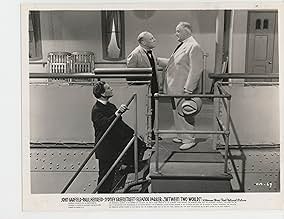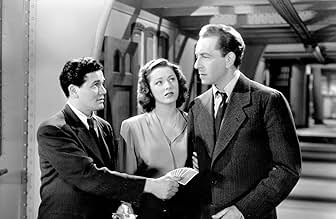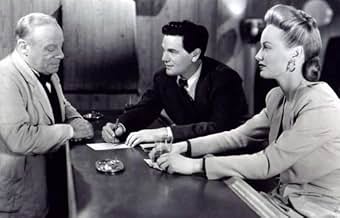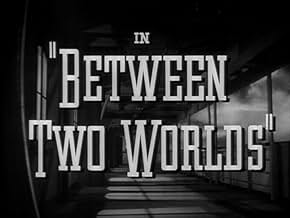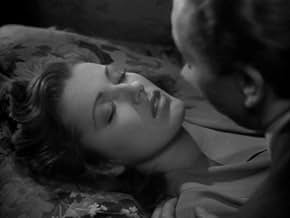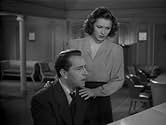IMDb RATING
7.1/10
2.6K
YOUR RATING
Passengers on an ocean liner can't recall how they got on board or where they are going yet, oddly enough, it soon becomes apparent that they all have something in common.Passengers on an ocean liner can't recall how they got on board or where they are going yet, oddly enough, it soon becomes apparent that they all have something in common.Passengers on an ocean liner can't recall how they got on board or where they are going yet, oddly enough, it soon becomes apparent that they all have something in common.
- Director
- Writers
- Stars
- Awards
- 4 wins total
Sami Ayanoglu
- Davis
- (uncredited)
Lester Matthews
- Steamship Dispatcher
- (uncredited)
Patrick O'Moore
- Steamship Clerk
- (uncredited)
- Director
- Writers
- All cast & crew
- Production, box office & more at IMDbPro
Featured reviews
This is a remake of the 1930 early-talkie "Outward Bound", which was based on the hit 1925 stage play. This version updates the period from the 1920's to the 1940's, and incorporates WW II elements into the story---a totally unnecessary tactic; the original play was quite good on its own and didn't need to have topical elements awkwardly sandwiched in. In fact,one of its strengths was that the entire unworldly experience seemed to take place in an unspecified time.
But this film has a very realistic beginning to it, and a war-related incident sets the plot in motion. The film's only serious blunder---though one that does not fatally affect it----is that we are tipped off as to what is really going on much too early in the film, in comparison to the 1930 film version, in which the characters realized their true situation at the same time as the audience did.
Aside from those objections, though, this is one of the few remakes which tops the original in nearly every department. Without exception, the actors in this version outdo the stiff, primitive early-talkie performances of their predecessors, and this may well be the only film in which Paul Henreid, normally not the most charismatic actor, gives a finer performance than the then-awkward Douglas Fairbanks,Jr. did in the same role in the 1930 film.
Especially outstanding are Edmund Gwenn as the ship's steward, Isobel Elsom as a rich, elderly, bitchy woman, Sydney Greenstreet as a mysterious character whose identity will not be revealed here, and Sara Allgood in one of the most sensitive performances of her career (she acts rings around Beryl Mercer from the 1930 version). George Coulouris, a reliable villain in those days (he was Orson Welles' nasty guardian in "Citizen Kane") is sinister and pompous as a greedy tycoon. And John Garfield is excellent in the Leslie Howard role, altered some to fit Garfield's tough, bitter on-screen persona rather than Howard's ultra-sophisticated, debonair one. (Garfield,though,does not go as berserk when he finds out the truth as Howard so hilariously did in the 1930 version.)
Although much of the dialogue in the first half has been changed and perhaps made slightly less "literary", the second half,which features Sydney Greensteet, is quite faithful to the earlier film and the stage play. Erich Wolfgang Korngold's music runs through nearly every scene, and, although verging toward the bombastic and melodramatic at times, lends plenty of atmosphere to the story.
One unfortunate aspect is that the photography in this version never becomes as eerie as that in the 1930 version, with its striking light and darkness effects. But none of these faults should keep you away from this film, which deserves far better than its relative obscurity in comparison to the other great Warner Bros. classics as well as other films dealing with the afterlife.
But this film has a very realistic beginning to it, and a war-related incident sets the plot in motion. The film's only serious blunder---though one that does not fatally affect it----is that we are tipped off as to what is really going on much too early in the film, in comparison to the 1930 film version, in which the characters realized their true situation at the same time as the audience did.
Aside from those objections, though, this is one of the few remakes which tops the original in nearly every department. Without exception, the actors in this version outdo the stiff, primitive early-talkie performances of their predecessors, and this may well be the only film in which Paul Henreid, normally not the most charismatic actor, gives a finer performance than the then-awkward Douglas Fairbanks,Jr. did in the same role in the 1930 film.
Especially outstanding are Edmund Gwenn as the ship's steward, Isobel Elsom as a rich, elderly, bitchy woman, Sydney Greenstreet as a mysterious character whose identity will not be revealed here, and Sara Allgood in one of the most sensitive performances of her career (she acts rings around Beryl Mercer from the 1930 version). George Coulouris, a reliable villain in those days (he was Orson Welles' nasty guardian in "Citizen Kane") is sinister and pompous as a greedy tycoon. And John Garfield is excellent in the Leslie Howard role, altered some to fit Garfield's tough, bitter on-screen persona rather than Howard's ultra-sophisticated, debonair one. (Garfield,though,does not go as berserk when he finds out the truth as Howard so hilariously did in the 1930 version.)
Although much of the dialogue in the first half has been changed and perhaps made slightly less "literary", the second half,which features Sydney Greensteet, is quite faithful to the earlier film and the stage play. Erich Wolfgang Korngold's music runs through nearly every scene, and, although verging toward the bombastic and melodramatic at times, lends plenty of atmosphere to the story.
One unfortunate aspect is that the photography in this version never becomes as eerie as that in the 1930 version, with its striking light and darkness effects. But none of these faults should keep you away from this film, which deserves far better than its relative obscurity in comparison to the other great Warner Bros. classics as well as other films dealing with the afterlife.
"Between Two Worlds" is one of the best examples of one of the rarest of move genres, a fantasy for grown-ups. I can't think of many other successful examples of this sort of thing off hand beyond, perhaps, Powell and Pressburger's "A Matter of Life and Death".
By "adult" I do not, of course, mean that there is anything off-color or X-rated about the film. On the contrary, it's pretty tame by today's standards. This film is simply a fantasy for adults in the sense that it was not for or about children or adolescents.
A small, ill-assorted group of people find themselves together at night on a fog-shrouded passenger ship with no other passengers, and no crew save for a single steward. Two of the passengers, who are slightly apart from the others, have committed suicide and are aware that they are dead. The others know nothing. The steward, who knows what is going on, caters to the passengers wishes and pretends that everything is normal.
The film is very well done, with a first-rate cast of the sort of character actors they simply can't assemble anymore, wonderfully atmospheric sets, and set against an excellent Korngold musical score. I understand there was an earlier version with Leslie Howard, called "Outward Bound". I've never seen it, but it would be interesting to see it and compare it with this version.
By "adult" I do not, of course, mean that there is anything off-color or X-rated about the film. On the contrary, it's pretty tame by today's standards. This film is simply a fantasy for adults in the sense that it was not for or about children or adolescents.
A small, ill-assorted group of people find themselves together at night on a fog-shrouded passenger ship with no other passengers, and no crew save for a single steward. Two of the passengers, who are slightly apart from the others, have committed suicide and are aware that they are dead. The others know nothing. The steward, who knows what is going on, caters to the passengers wishes and pretends that everything is normal.
The film is very well done, with a first-rate cast of the sort of character actors they simply can't assemble anymore, wonderfully atmospheric sets, and set against an excellent Korngold musical score. I understand there was an earlier version with Leslie Howard, called "Outward Bound". I've never seen it, but it would be interesting to see it and compare it with this version.
The dead victims of a London bombing and two suicides are on a ship headed - well, they're not sure - in "Between Two Worlds," a 1944 film starring John Garfield, Sydney Greenstret, Paul Henried, Eleanor Parker, Edmund Gwenn, Faye Emerson and George Coulouris. The suicides, a married couple played by Henried and Parker, are the only ones at first who realize they're dead, but the others find out soon enough. Then they learn that "The Examiner" will be coming on board to evaluate them and decide their final destination.
The film employs a stark set for the ship, and it works beautifully as the tense passengers wait to learn their individual fates.
The acting is marvelous all around. Eleanor Parker reminded me very much of Gene Tierney - at first, I didn't recognize her until I heard her voice. She and Henried are excellent as the only two people who have chosen their destinies. Parker's role especially is written almost melodramatically so at times, she seems over the top, but the story seems to call for it. Greenstreet, with his powerful presence, makes a good examiner. Faye Emerson is lovely as an actress who made a lot of wrong choices, and John Garfield is strong as a belligerent no-good whose life didn't add up to much.
During World War II, it's not surprising that people were giving a lot of thought to the afterlife. After World War II, there were all kinds of films about people come back to earth and angels walking among us. The view of "Between Two Worlds" is that each of us makes our own heaven and hell on earth, that in the end, we sow what we reap, and that love is stronger than any other force. I loved it.
The film employs a stark set for the ship, and it works beautifully as the tense passengers wait to learn their individual fates.
The acting is marvelous all around. Eleanor Parker reminded me very much of Gene Tierney - at first, I didn't recognize her until I heard her voice. She and Henried are excellent as the only two people who have chosen their destinies. Parker's role especially is written almost melodramatically so at times, she seems over the top, but the story seems to call for it. Greenstreet, with his powerful presence, makes a good examiner. Faye Emerson is lovely as an actress who made a lot of wrong choices, and John Garfield is strong as a belligerent no-good whose life didn't add up to much.
During World War II, it's not surprising that people were giving a lot of thought to the afterlife. After World War II, there were all kinds of films about people come back to earth and angels walking among us. The view of "Between Two Worlds" is that each of us makes our own heaven and hell on earth, that in the end, we sow what we reap, and that love is stronger than any other force. I loved it.
I finally had an opportunity to see this largely "forgotten" film, one of my favorites dealing in a mystical way with the afterlife. A remake of "Outward Bound" ('30), it was updated to World War II and begins with an air raid in which several people are unable to seek shelter. Afterwards, they find themselves on a strange ship and only gradually come to realize they are all dead--and about to be judged by a man called The Examiner (Sydney Greenstreet). The disparate group of people include some of the dependable Warner contract players: John Garfield, Eleanor Parker, Paul Henried, Faye Emerson, Edmund Gwenn, Isobel Elmson and Sara Allgood.
Thoughtful and well written (though talky and showing its stage origins), it permits us to examine the passengers one by one as they reveal their fears and foibles--each having substantial roles in a series of vignettes that will lead to their ultimate destination--heaven or hell.
It's fascinating, handsomely produced amid low-key film noir lighting and the performances are all first-rate. John Garfield and Paul Henried give the strongest performances in the meatiest roles but the others are all more than competent, including the lovely Eleanor Parker.
Erich Wolfgang Korngold's score happens to be one of his personal "favorites" and I can certainly see why. It is melancholy, lyrical and mysterious--in keeping with the "otherworldly" elements of a film about passengers on their way to another world.
An oddly interesting film, thought provoking and well worth viewing. It's a wonder no one has produced a remake since the material lends itself to endless possibilities.
Thoughtful and well written (though talky and showing its stage origins), it permits us to examine the passengers one by one as they reveal their fears and foibles--each having substantial roles in a series of vignettes that will lead to their ultimate destination--heaven or hell.
It's fascinating, handsomely produced amid low-key film noir lighting and the performances are all first-rate. John Garfield and Paul Henried give the strongest performances in the meatiest roles but the others are all more than competent, including the lovely Eleanor Parker.
Erich Wolfgang Korngold's score happens to be one of his personal "favorites" and I can certainly see why. It is melancholy, lyrical and mysterious--in keeping with the "otherworldly" elements of a film about passengers on their way to another world.
An oddly interesting film, thought provoking and well worth viewing. It's a wonder no one has produced a remake since the material lends itself to endless possibilities.
I haven't seen this movie for decades, but I still remember it well. It has a haunting 'twilight zone' twist to it and is very entertaining. I'm surprised, in this in this 'post Titanic megahit' time, that an ocean liner backdrop to an eerie, romantic story has not been recycled as was 'Death Takes a Holiday'. It might even be re-incarnated as a 'Fantasy Island' type TV series with new passengers every week.
You expect justice and good to win out in movies of this era. It's nice they left enough 'wiggle' room to do the right thing. And I think people take a comfort from a good movie showing us going on after death. It's a trip we all hope to take one day....
You expect justice and good to win out in movies of this era. It's nice they left enough 'wiggle' room to do the right thing. And I think people take a comfort from a good movie showing us going on after death. It's a trip we all hope to take one day....
Did you know
- TriviaComposer Erich Wolfgang Korngold named this film as his personal favorite among his film scores.
- GoofsWhen the Bergners first arrive aboard the ship, the shadow of a klieg light can be seen on one of the double doors as they pass through.
- Alternate versionsTwo versions of the movie exist. The latest, published by Warner Archive in Sept. 2006, is the 112 minute cut. Another version of 121 minutes, including a rarely seen cut scene between Ann and Tom and a few additional shots of the casino parts, has been broadcast by a few TV networks in the 2000s in Europe and East Asia.
- ConnectionsFeatured in Between Two Worlds: Erich Wolfgang Korngold (2005)
Details
- Runtime
- 1h 52m(112 min)
- Color
- Aspect ratio
- 1.37 : 1
Contribute to this page
Suggest an edit or add missing content


